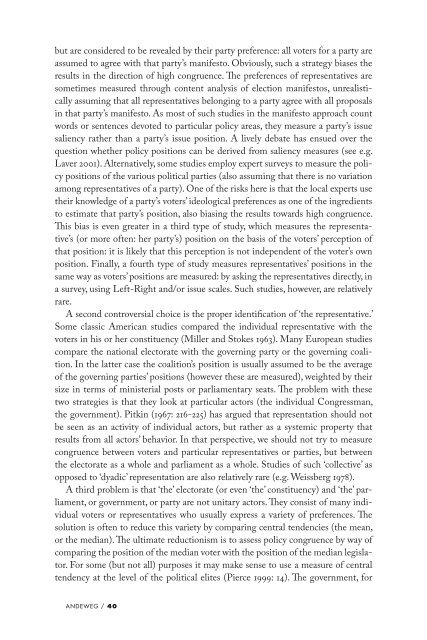download - UvA DARE
download - UvA DARE
download - UvA DARE
You also want an ePaper? Increase the reach of your titles
YUMPU automatically turns print PDFs into web optimized ePapers that Google loves.
ut are considered to be revealed by their party preference: all voters for a party are<br />
assumed to agree with that party’s manifesto. Obviously, such a strategy biases the<br />
results in the direction of high congruence. The preferences of representatives are<br />
sometimes measured through content analysis of election manifestos, unrealistically<br />
assuming that all representatives belonging to a party agree with all proposals<br />
in that party’s manifesto. As most of such studies in the manifesto approach count<br />
words or sentences devoted to particular policy areas, they measure a party’s issue<br />
saliency rather than a party’s issue position. A lively debate has ensued over the<br />
question whether policy positions can be derived from saliency measures (see e.g.<br />
Laver 2001). Alternatively, some studies employ expert surveys to measure the policy<br />
positions of the various political parties (also assuming that there is no variation<br />
among representatives of a party). One of the risks here is that the local experts use<br />
their knowledge of a party’s voters’ ideological preferences as one of the ingredients<br />
to estimate that party’s position, also biasing the results towards high congruence.<br />
This bias is even greater in a third type of study, which measures the representative’s<br />
(or more often: her party’s) position on the basis of the voters’ perception of<br />
that position: it is likely that this perception is not independent of the voter’s own<br />
position. Finally, a fourth type of study measures representatives’ positions in the<br />
same way as voters’ positions are measured: by asking the representatives directly, in<br />
a survey, using Left-Right and/or issue scales. Such studies, however, are relatively<br />
rare.<br />
A second controversial choice is the proper identification of ‘the representative.’<br />
Some classic American studies compared the individual representative with the<br />
voters in his or her constituency (Miller and Stokes 1963). Many European studies<br />
compare the national electorate with the governing party or the governing coalition.<br />
In the latter case the coalition’s position is usually assumed to be the average<br />
of the governing parties’ positions (however these are measured), weighted by their<br />
size in terms of ministerial posts or parliamentary seats. The problem with these<br />
two strategies is that they look at particular actors (the individual Congressman,<br />
the government). Pitkin (1967: 216-225) has argued that representation should not<br />
be seen as an activity of individual actors, but rather as a systemic property that<br />
results from all actors’ behavior. In that perspective, we should not try to measure<br />
congruence between voters and particular representatives or parties, but between<br />
the electorate as a whole and parliament as a whole. Studies of such ‘collective’ as<br />
opposed to ‘dyadic’ representation are also relatively rare (e.g. Weissberg 1978).<br />
A third problem is that ‘the’ electorate (or even ‘the’ constituency) and ‘the’ parliament,<br />
or government, or party are not unitary actors. They consist of many individual<br />
voters or representatives who usually express a variety of preferences. The<br />
solution is often to reduce this variety by comparing central tendencies (the mean,<br />
or the median). The ultimate reductionism is to assess policy congruence by way of<br />
comparing the position of the median voter with the position of the median legislator.<br />
For some (but not all) purposes it may make sense to use a measure of central<br />
tendency at the level of the political elites (Pierce 1999: 14). The government, for<br />
AndeWeg / 40
















